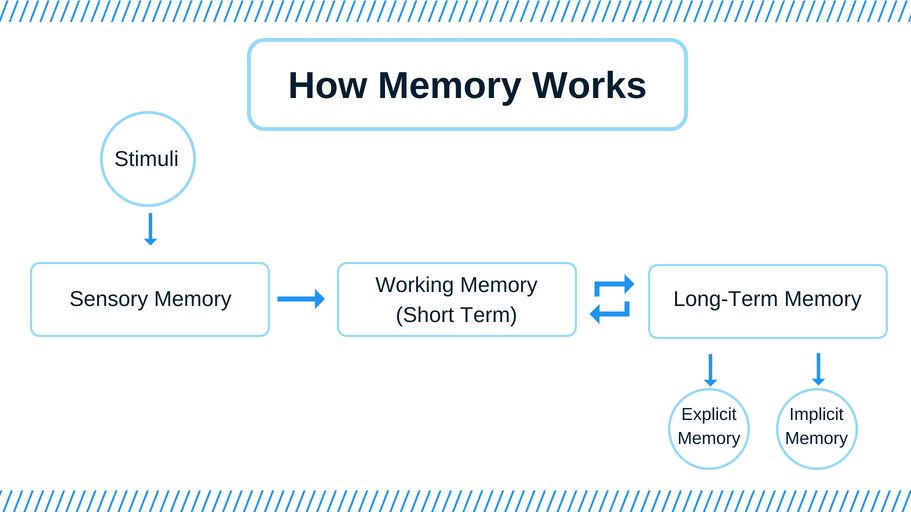There’s so much noise in the digital world that even getting in front of your audience can be a struggle—let alone making a lasting impression.
Fortunately, psychology research on memory can provide insight on how to build a memorable marketing campaign. And as a psychology-buff-turned-marketer, I have quite a few applications to share.
First Things First—How Memory Works
Our memory system is not as simple as it may seem. Baddeley and Hitch created the working memory model in 1974. In their model, the human memory system is broken down based on how long it’s stored and then by what type of memory it is. Check it out:

Now, let’s dive into memory phenomena that can improve your marketing campaigns and strategy.
Three Memory Theories That Can Impact a Marketing Campaign Strategy
Priming, the mere exposure effect, and the spacing effect are three memory theories that can help make your marketing campaign more memorable.
1. Prime Your Audience
When I say macaroni, you think cheese. Or when I say content you think marketing. We all have a countless number of word pairings like these in our heads and they didn’t just show up overnight.
That’s because you’ve been primed to group these items together over years of repetition. Priming is the implicit memory process of creating associations between objects and words. Priming helps us organize our memories and make sense of the world we live in.
So, what does priming actually look like in your campaigns? There are many ways you can strategically prime your audience. Priming can be done through images, tasks, smells, words and so on.
For example, when deciding on images for a marketing campaign, look for graphics that properly reflect exactly what you want your audience to come away with. If you want people to associate your campaign with joy, choose bright and cheerful images. The same idea goes with the words chosen for the campaign’s copy. The goal is to have your audience remember the campaign in the way you intended.
To have your audience recall your campaign the way you intended, you have to ensure the images and copy your chose are on brand. Having a consistent brand voice proves to be important when priming your audience. The more inconsistent your brand voice is, the harder it is to prime your audience. Priming is about building a mental association through repetition, and consistency is key for repetition.
Basically, think about what the campaign should be associated with and make sure that comes off clear in your chosen images and words.
2. Mere Exposure Effect
Once you think of the impact you want your campaign to have on your audience, the next step is sharing it. But are people going to like your new campaign? Well, research shows that just being exposed to something multiple times makes us like it more.
The mere exposure effect (also known as the familiarity principle) is the idea that the more someone is exposed to something and the more it becomes familiar, the more they like it. This phenomenon was researched heavily in the 1960s by Robert Zajonc.
For example, think about the last time you heard a new song played on the radio. Most people don’t like a song the first time they hear it, but the more you hear the song—and the more familiar you become with it—the more you end up liking it.
Getting the campaign message out and in front of people is important, even if they’re not directly engaging with it at first.
Consider how the mere exposure effect can be directly applied to a cross-channel strategy. The goal is to use different channels to share the same content to improve the customer experience. By exposing your audience to the same content through various channels the more important the assets will seem because it’s more familiar because they’ve been exposed to it multiple times on various channels.
They may not engage with the content the first time or two they see it in an email, but eventually, while scrolling through LinkedIn, they see the content again and finally click on it because it has become more familiar to them.
Now, the trick is walking the fine line between overexposure of the content and the right amount that doesn’t annoy the target audience.
3. Spacing Effect
It is important to play it cool and spread out the frequency of the content. As you’re priming your audience to have a certain perception of your brand, desperate certainly shouldn’t be the impression you want to make.
Enter the spacing effect. The spacing effect is popular in education and studying methods. The idea is that if someone spaces out their learning, then they’re more likely to remember it compared to other learning strategies. This goes back to how memory works. The more someone retrieves information over time and builds that association in their memory, the more likely they are to keep it in long-term memory.
Think back to your years in school: Did cramming ever work as well as you wanted it to? Probably not. But when you study in intervals and space out the studying over a period of time you learn better. When you study in four times a week in one-hour sprints, you will retain the information better than when you drink a pot of coffee and study once for a four hour time period.
Enabling your audience to remember your content means you can’t send out one message and hope they memorize everything. But you also can’t bombard them with a bunch of content all at once during every waking hour. It has to be spaced out.
There is no magic equation to decide the right frequency a company should be posting. You should post enough to stay relevant but once the quality starts to suffer because of the quantity you’re trying to push then it’s time to dial it back. This is especially important when determining how often to post a blog because you never want the quality of the writing to suffer just to push more posts.
By spacing out the campaign content strategically, you’ll help your audience learn and remember the content better.
Key Takeaways
Prime, expose, space, repeat.
Priming, the mere exposure effect, and the spacing effect all work together within different parts of our memory system so a truly effective campaign needs to include all of these things. For your message to have the most impact, keep the message consistent to properly prime your audience, space out the frequency of the posting, and share the content on multiple platforms to increase exposure. Doing all of this will help your audience remember your campaign better.
When planning your next marketing campaign don’t you forget about these psychological insights.
Ready to incorporate these strategies into your next campaign? Get started with these templates.



